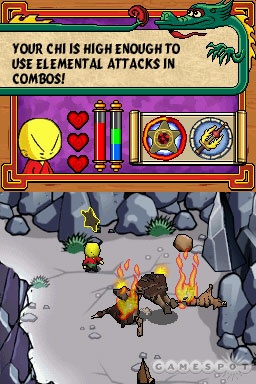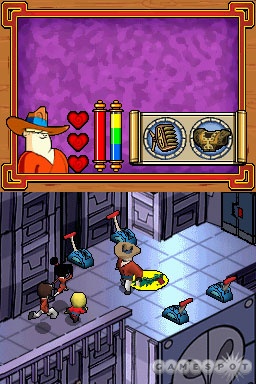For those of you who aren't familiar with the Xiaolin Showdown animated TV show, all you really need to know is that it involves two rival gangs of young martial artists who are constantly fighting each other and participating in bizarre competitions to acquire magical objects called Shen Gong Wu. These Shen Gong Wu give the bearer the ability to perform powerful elemental attacks or to cast curses on people. The Nintendo DS rendition of Xiaolin Showdown is an adventurous beat-'em-up that incorporates all of the show's signature aspects. In the game, you choose from four different Xiaolin warriors and use your chosen character's fisticuffs and magic to work through dozens of huge levels populated with automated hazards and rival Heylin warriors. The gorgeous cel-shaded graphics grab hold of your attention right from the start, and the game does a good job of maintaining that attention by constantly introducing new enemies and giving you additional attack moves. Problems related to hit detection and character movement suck away some of the fun, but not so much that fans of the show won't enjoy themselves. Ultimately, the real tragedy is how the development team neglected to take advantage of the system's wireless capabilities and implement a co-op mode.

As beat-'em-ups go, this one is eye-catching, lively, and packed with variety. The isometric viewpoint and cel-shaded graphics bring the world of Xiaolin Showdown to life without skimping on flair or detail. Many rooms have machines operating in them or structures that fall apart when you walk past them. In most rooms, you can pick up and smash objects such as tables and chairs. Character animation is fluid and whimsical. Sure, the fighting is violent, but the violence in this game is more goofball than serious. The brief comments the characters make when taking damage or performing Shen Gong Wu attacks also lighten the mood quite a bit. The developers could have come up with music more appropriate than the orchestral anthems that play from room to room, but the music is at least catchy and of a high quality. All told, the game looks and sounds like a modernized take on one of Konami's classic arcade beat-'em-ups from yesteryear.
Xiaolin Showdown is also more ambitious in scope than the typical beat-'em-up. A single level can take as much as a half hour to finish. Each level incorporates a multitude of hallways and optional rooms. In most of those rooms, you'll face wave after wave of enemies, which you have to dispatch by beating the living daylights out of them. Each enemy has two or three different attacks, and the CPU generally does a good job of mixing up attacks, retreating, or ganging up on your character based on the situation. Every hit you take will drain your character's health by a small amount. The goal is to get through each level without running out of health three times, thus using up all three of your character's lives. For your part, each of the four characters you can pick from can punch, kick, jump, and block, as well as pick up and toss certain enemies and objects. Punches and kicks can be chained together to perform stylish combinations. Each character knows only a couple of combinations at the beginning of the game, but you can add new combinations to his arsenal by spending experience points at the temple between levels. When your character's chi meter is filled to a certain point, you can perform a Shen Gong Wu attack. These attacks are flashy and tend to take out multiple enemies in a single use. Before a level begins, you get to pick two Shen Gong Wu abilities for your character. There are only four Shen Gong Wu to choose from at the beginning of the game, but you can unlock as many as 20 by collecting the amulets that are scattered throughout the levels.
In the show, if two rival fighters grab a Shen Gong Wu at the same time, they have to participate in a Xiaolin showdown to see who gets to keep the prize. These showdowns aren't no-holds-barred fights. Instead, they usually take the form of bizarre talent competitions. These wacky showdowns have been implemented in the game as minigame challenges. In various spots, a Heylin stooge will appear and challenge your character to one of four different minigames. These minigames all employ the use of the touch screen and involve such off-the-wall tasks as choreographed cheering or river rafting. While these minigames certainly feel out of place in a beat-'em-up-style game, they're tolerable here because they're not overly complex and provide an occasional breather from the otherwise constant fisticuffs.
While the game is generally enjoyable, it does suffer from a few annoying problems related to hit detection and character movement. The isometric viewpoint can make jumping over hazards or across gaps difficult. Practically speaking, that's not a big deal, since each level has only a few spots where you need to jump over something. Nevertheless, it's frustrating to lose some health or an entire life just because the skewed graphics led you astray. The hit detection can also be bothersome at times. Attacks have a tendency to connect even if they miss by a few pixels. This is most obvious with magic and projectile attacks, which can hit even when there's a full character's width of space between you and the explosion. As annoying as those flaws are, at least they're intermittent. A more constant annoyance is the sluggish speed at which the characters move. The heroes walk so slowly that enemies can outrun them just by walking backward! It doesn't take long before you figure out that you can cover twice as much ground by jumping, which means that you'll soon find yourself hopping around like a bunny rabbit in order to be able to move at a reasonable pace. None of these problems ruin the game, but they're certainly the sort of obvious sloppiness that should have been fixed during the development process.

By far, however, the biggest oversight is the lack of a cooperative play mode. The four bonus minigames allow two players to compete wirelessly, but the main mode is strictly a solo undertaking. That's tragic, considering that beat-'em-ups are infinitely more fun when a second player is involved. It's also not too much of a stretch to think that people would be more tolerant of the flaws mentioned above if they were able to play through the game with a friend. Further adding salt to the wound is the realization that the game seems to have been designed with co-op play in mind. The hallways and rooms in the levels are spacious, the game can push a half-dozen enemy characters without slowing down, and the character roster already lets you pick from four different heroes. The only thing that's missing is the option to invite a friend into a game.
All things considered, Xiaolin Showdown is a decent beat-'em-up that will probably satisfy fans of the show it's based on. You have to wonder, however, just how awesome the game might have been if the developer had only taken the time to iron out the kinks or to implement a co-op mode.